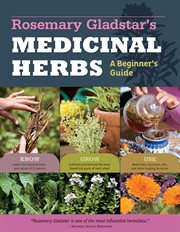Rosemary Gladstar's medicinal herbs A beginner's guide
eBook - 2012
Craft a soothing aloe lotion after an encounter with poison ivy, make a dandelion-burdock tincture to fix sluggish digestion, and brew up some lavender-lemon balm tea to ease a stressful day. In this introductory guide, Rosemary Gladstar shows you how easy it can be to make your own herbal remedies for life's common ailments. Gladstar profiles 33 common healing plants and includes advice on growing, harvesting, preparing, and using herbs in healing tinctures, oils, and creams. Stock your medicine cabinet full of all-natural, low-cost herbal preparations. With this bestselling book by Rosemary Gladstar, the godmother of modern herbalism, learn how to grow, harvest, prepare, and use the 33 most common and versatile healing plants. Everyo...ne will love this guide to inexpensive and natural home-healing! Rosemary Gladstar is the best-selling author of Rosemary Gladstar's Medicinal Herbs: A Beginner's Guide and Rosemary Gladstar's Herbal Recipes for Vibrant Health, which draw on her 40-plus years of experiences studying and teaching about the healing properties of herbs. She is a world-renowned educator, activist, and entrepreneur, and the founding director of Sage Mountain Herbal Retreat Center, the International Herb Symposium, and the New England Women's Herbal Conference. Gladstar is founding president of United Plant Savers, a nonprofit organization dedicated to the conservation and preservation of native American herbs. She was the original formulator for Traditional Medicinal herbal teas and has led herbal educational adventures around the world. She is the recipient of an honorary doctorate from the National University of Natural Medicine in Portland, Oregon, and serves on the board of the Association for the Advancement of Restorative Medicine and The National Health Freedom Coalition. She lives in Vermont. Infusions and Decoctions When making tea, leaves and flowers are prepared differently from roots and bark, in much the same way that spinach is cooked differently from potatoes. Leaves and flowers are generally steeped in hot water so as not to overcook and destroy the enzymes, vitamins, and precious essential oils. Roots and bark are generally simmered to draw forth the more tenacious plant constituents. There are a few exceptions to these rules, which you'll generally find noted in herb books, including this one. But honestly, if you make a mistake and simmer a root that should have been steamed, don't panic. Your remedy will still work. The process of steeping a plant in boiling water is called infusion, while the process of simmering a plant in lightly boiling water is called decoction. When in doubt, steep. Steeping is much less destructive to many of the important medicinal components of plants. The longer you steep the herbs, the stronger the tea. That's not always preferable, as long steeping times can bring out some of the less desirable parts of the plant. Steep black tea too long and what happens? It goes from being a fragrant, aromatic beverage to an astringent-tasting, tannin-rich medicinal tea. A medicinal tea blend, whether an infusion or a decoction, is defined by its strength and potency. For medicinal purposes, teas need to be fairly strong, and so you'll use a relatively large amount of herbs in making them. How to Make a Medicinal INFUSION Infusions are made from the more delicate parts of the plant, such as the leaves, flowers, buds, some berries and seeds, and other aromatic plant parts. Highly aromatic roots such as valerian, ginger, and goldenseal are often steeped rather than decocted, though I find they are effective either way. After, add the spent herbs to your compost. Here are the basic steps. Instructions - Put 4 to 6 tablespoons of dried herb (or 6 to 8 tablespoons of fresh herb) into a glass quart jar. - Pour boiling water...
- Subjects
- Published
-
[United States] :
Storey Publishing, LLC
2012.
- Language
- English
- Corporate Author
- Main Author
- Corporate Author
- Online Access
- Instantly available on hoopla.
Cover image - Physical Description
- 1 online resource
- Format
- Mode of access: World Wide Web.
- ISBN
- 9781603428293
- Access
- AVAILABLE FOR USE ONLY BY IOWA CITY AND RESIDENTS OF THE CONTRACTING GOVERNMENTS OF JOHNSON COUNTY, UNIVERSITY HEIGHTS, HILLS, AND LONE TREE (IA).

